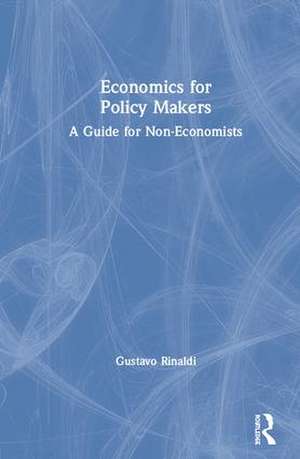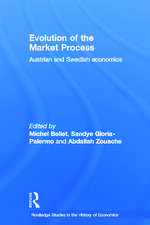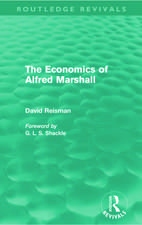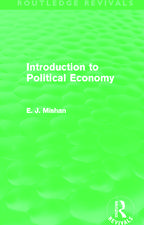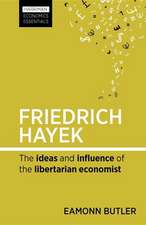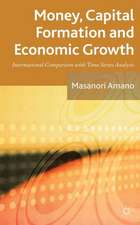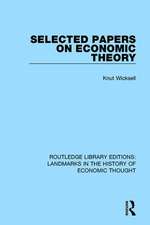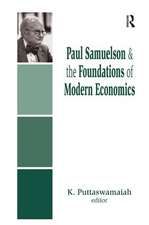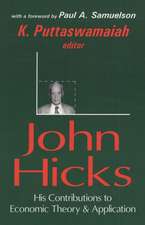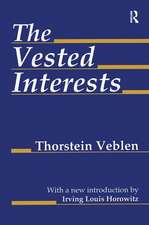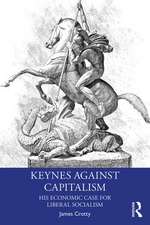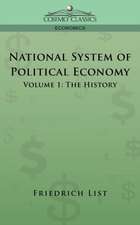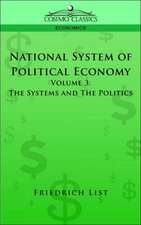Economics for Policy Makers: A Guide for Non-Economists
Autor Gustavo Rinaldien Limba Engleză Hardback – 30 apr 2019
This book makes economics easily available to everyone. The author’s use of simple language and avoidance of technical jargon provides non-economists with a better understanding of economic reasoning and the tools "to know and to decide". The author achieves this through introducing key concepts in short presentations and arming the reader with selected press articles and recent research using these concepts. An analysis of these demonstrates how a general concept can be derived from a specific context and highlighted questions provide the basis for further debate. The reader can then focus on the parts most relevant to their own needs.
This book will have great appeal to employers, trade unionists and public officials attending courses organized by international institutions, professional training providers, as well as graduate students of courses where economics is an important element, especially in relation to its policy implications. Finally, it is invaluable for anybody who has wanted to learn the basics of practical economics but has been deterred by its technicalities.
| Toate formatele și edițiile | Preț | Express |
|---|---|---|
| Paperback (1) | 296.65 lei 3-5 săpt. | +23.69 lei 4-10 zile |
| Taylor & Francis – 2 mai 2019 | 296.65 lei 3-5 săpt. | +23.69 lei 4-10 zile |
| Hardback (1) | 1007.36 lei 6-8 săpt. | |
| Taylor & Francis – 30 apr 2019 | 1007.36 lei 6-8 săpt. |
Preț: 1007.36 lei
Preț vechi: 1228.49 lei
-18% Nou
Puncte Express: 1511
Preț estimativ în valută:
192.82€ • 209.52$ • 162.07£
192.82€ • 209.52$ • 162.07£
Carte tipărită la comandă
Livrare economică 21 aprilie-05 mai
Preluare comenzi: 021 569.72.76
Specificații
ISBN-13: 9781138388802
ISBN-10: 1138388807
Pagini: 348
Ilustrații: 44
Dimensiuni: 156 x 234 x 21 mm
Greutate: 0.66 kg
Ediția:1
Editura: Taylor & Francis
Colecția Routledge
Locul publicării:Oxford, United Kingdom
ISBN-10: 1138388807
Pagini: 348
Ilustrații: 44
Dimensiuni: 156 x 234 x 21 mm
Greutate: 0.66 kg
Ediția:1
Editura: Taylor & Francis
Colecția Routledge
Locul publicării:Oxford, United Kingdom
Public țintă
Postgraduate, Professional, and UndergraduateCuprins
Foreword
Acknowledgments
MICROECONOMICS
Part I INTRODUCTION
Chapter 1 ECONOMIC PROFIT
1.1 The Value of the Best Foregone Alternative: The Opportunity Cost
1.2 Sunk Costs vs Recoverable Costs
1.3 Accounting Profit
1.4 The Economic Profit: Comparing Two Scenarios
1.5 Different Objectives of the Firms
Chapter 2 VALUE ADDED
2.1 Intermediate Consumption and Value Added
2.2 Value Added and Vertical Integration
Part II PRODUCTION AND COSTS
Chapter 3 PRODUCTION AND PRODUCTIVITY
3.1 Rigid and Flexible Production Techniques
3.2 The Measurement of Efficiency
3.3 Marginal Productivity
3.4 The Cornerstone of Industrial Negotiations: Unit Labour Cost
Chapter 4 COSTS
4.1 Fixed Costs and Variable Costs
4.2 Marginal and Average Costs
4.3 Types of Costs
4.4 The Supply: Is the Firm Ready to Sell a Certain Quantity? At What Price?
4.5 A Special Cost: The Cost of Using the Market or Transaction Cost
Chapter 5 ECONOMIES OF SCALE
5.1 Reducing the Average Cost of a Firm
5.2 The Causes of Economies of Scale
5.3 The Limits to Economies of Scale
5.4 The Minimum Efficient Size and Concentration
Part III CUSTOMERS AND COMPETITORS
Chapter 6 DEMAND FOR THE PRODUCTS OF AN INDUSTRY AND OF A MONOPOLIST
6.1 An Industry and the Demand for its Product
6.2 Demand and Supply
6.3 Total Revenue and Marginal Revenue
6.4 Price-Elasticity
6.5 The Effects of Income on Demand: Income-Elasticity
6.6 Price Cross-Elasticity: Complements and Substitutes
Chapter 7 MARKET ENVIRONMENTS
7.1 Monopoly
7.2 Perfect Competition
7.3 Oligopoly
7.4 Monopolistic Competition
MACROECONOMICS
Part IV INTRODUCTION TO MACROECONOMICS
Chapter 8 KEY WORDS OF NATIONAL ACCOUNTS
8.1 Supply (Sources) of Goods: Production (GDP) and Imports
8.2 Uses of Goods: Household Consumption, Private Investment, Government
Spending and Export
Chapter 9 MONEY AND PRICES
9.1 Money and other Financial Assets
9.2 The Demand for and Supply of Money and the Interest Rate
9.3 Money Supply and Prices
9.4 How much inflation is "too much"?
Part V FOREIGN ECONOMIC RELATIONS
Chapter 10 THE FOREIGN TRADE OF GOODS: EXPORTS AND IMPORTS
10.1 The Quality of Goods
10.2 The (Nominal) Exchange Rate and the Exchange Rate Regimes
10.3 The Real Exchange Rate
10.4 The Determinants of Imports
10.5 The Determinants of Exports
Chapter 11 FINANCIAL MOVEMENTS
11.1 Main Types of Financial Movements
11.2 Advantages and Disadvantages of Foreign Portfolio Investments
11.3 Advantages and Disadvantages of Foreign Direct Investment (FDI)
11.4 The Freedom of Movement of Capital
Chapter 12 INTERNATIONAL ACCOUNTS
12.1 The Current Account of the Balance of Payments
12.2 The Capital Account of the Balance of Payments
12.3 The Financial Account of the Balance of Payments
12.4 The International Investment Position (IIP)
Part VI FISCAL POLICY
Chapter 13 MONETARY TRANSFERS: TAXES, BENEFITS, SUBSIDIES AND SOCIAL CONTRIBUTIONS
13.1 General Taxation: Taxes not Earmarked to Fund Specific Expenses
13.2 Earmarked Monetary Transfers Between Private Subjects and Government:
Social Contributions, Pensions and Benefits
13.3 The Macroeconomic Effects of Taxes (and Social Contributions)
Chapter 14 GOVERNMENT SPENDING ON GOODS AND SERVICES
14.1 Public Employment
14.2 Public Procurement
Chapter 15 PUBLIC SPENDING ON EDUCATION, TRAINING, RESEARCH AND DEVELOPMENT (R&D)
15.1 Education and Training
15.2 Public Expenditure in R&D
15.3 Government Expenditure in Education and R&D and its Macroeconomic Effects
Chapter 16 PUBLIC DEFICIT AND PUBLIC DEBT
16.1 The Public Budget and the Public Deficit
16.2 The Public Debt and the Market for Sovereign Bonds
16.3 The Sustainability of a Public Debt
Part VII PRIVATE DEMAND
Chapter 17 HOUSEHOLD CONSUMPTION: THE MAIN DESTINATION OF
GOODS AND SERVICES
17.1 The Main Features of Household Consumption
17.2 The Determinants of Consumption
17.3 Disposable Income Which is not Consumed: Savings
Chapter 18 PRIVATE INVESTMENT: SUPPLYING THE PRIVATE SECTOR WITH
NEW CAPITAL
18.1 The Net Present Value (NPV) Method for Firms’ Investment Decision
18.2 The Main Features of Investment
Part VIII THE LABOUR MARKET AND INEQUALITY
Chapter 19 THE LABOUR MARKET
19.1 A Basic Description of Labour Market Stocks and Flows
19.2 Key Indicators of the Labour Market (KILM)
19.3 The Determinants of Salaries
19.4 Economic Growth and Unemployment
19.5 Unemployment and Prices
Chapter 20 INCOME DISTRIBUTION AND ITS EFFECTS
20.1 The Nature of Inequality
20.2 The Change of Inequality and its Effects
20.3 Causes of and Remedies for Inequality
APPENDIX – INDEXES OF COMPETITIVENESS
A) Global Competitiveness Index (GCI)
B) World Competitiveness Ranking (WCR)
C) Doing Business Indicators (DBI)
D) Discussion
Index
Acknowledgments
MICROECONOMICS
Part I INTRODUCTION
Chapter 1 ECONOMIC PROFIT
1.1 The Value of the Best Foregone Alternative: The Opportunity Cost
1.2 Sunk Costs vs Recoverable Costs
1.3 Accounting Profit
1.4 The Economic Profit: Comparing Two Scenarios
1.5 Different Objectives of the Firms
Chapter 2 VALUE ADDED
2.1 Intermediate Consumption and Value Added
2.2 Value Added and Vertical Integration
Part II PRODUCTION AND COSTS
Chapter 3 PRODUCTION AND PRODUCTIVITY
3.1 Rigid and Flexible Production Techniques
3.2 The Measurement of Efficiency
3.3 Marginal Productivity
3.4 The Cornerstone of Industrial Negotiations: Unit Labour Cost
Chapter 4 COSTS
4.1 Fixed Costs and Variable Costs
4.2 Marginal and Average Costs
4.3 Types of Costs
4.4 The Supply: Is the Firm Ready to Sell a Certain Quantity? At What Price?
4.5 A Special Cost: The Cost of Using the Market or Transaction Cost
Chapter 5 ECONOMIES OF SCALE
5.1 Reducing the Average Cost of a Firm
5.2 The Causes of Economies of Scale
5.3 The Limits to Economies of Scale
5.4 The Minimum Efficient Size and Concentration
Part III CUSTOMERS AND COMPETITORS
Chapter 6 DEMAND FOR THE PRODUCTS OF AN INDUSTRY AND OF A MONOPOLIST
6.1 An Industry and the Demand for its Product
6.2 Demand and Supply
6.3 Total Revenue and Marginal Revenue
6.4 Price-Elasticity
6.5 The Effects of Income on Demand: Income-Elasticity
6.6 Price Cross-Elasticity: Complements and Substitutes
Chapter 7 MARKET ENVIRONMENTS
7.1 Monopoly
7.2 Perfect Competition
7.3 Oligopoly
7.4 Monopolistic Competition
MACROECONOMICS
Part IV INTRODUCTION TO MACROECONOMICS
Chapter 8 KEY WORDS OF NATIONAL ACCOUNTS
8.1 Supply (Sources) of Goods: Production (GDP) and Imports
8.2 Uses of Goods: Household Consumption, Private Investment, Government
Spending and Export
Chapter 9 MONEY AND PRICES
9.1 Money and other Financial Assets
9.2 The Demand for and Supply of Money and the Interest Rate
9.3 Money Supply and Prices
9.4 How much inflation is "too much"?
Part V FOREIGN ECONOMIC RELATIONS
Chapter 10 THE FOREIGN TRADE OF GOODS: EXPORTS AND IMPORTS
10.1 The Quality of Goods
10.2 The (Nominal) Exchange Rate and the Exchange Rate Regimes
10.3 The Real Exchange Rate
10.4 The Determinants of Imports
10.5 The Determinants of Exports
Chapter 11 FINANCIAL MOVEMENTS
11.1 Main Types of Financial Movements
11.2 Advantages and Disadvantages of Foreign Portfolio Investments
11.3 Advantages and Disadvantages of Foreign Direct Investment (FDI)
11.4 The Freedom of Movement of Capital
Chapter 12 INTERNATIONAL ACCOUNTS
12.1 The Current Account of the Balance of Payments
12.2 The Capital Account of the Balance of Payments
12.3 The Financial Account of the Balance of Payments
12.4 The International Investment Position (IIP)
Part VI FISCAL POLICY
Chapter 13 MONETARY TRANSFERS: TAXES, BENEFITS, SUBSIDIES AND SOCIAL CONTRIBUTIONS
13.1 General Taxation: Taxes not Earmarked to Fund Specific Expenses
13.2 Earmarked Monetary Transfers Between Private Subjects and Government:
Social Contributions, Pensions and Benefits
13.3 The Macroeconomic Effects of Taxes (and Social Contributions)
Chapter 14 GOVERNMENT SPENDING ON GOODS AND SERVICES
14.1 Public Employment
14.2 Public Procurement
Chapter 15 PUBLIC SPENDING ON EDUCATION, TRAINING, RESEARCH AND DEVELOPMENT (R&D)
15.1 Education and Training
15.2 Public Expenditure in R&D
15.3 Government Expenditure in Education and R&D and its Macroeconomic Effects
Chapter 16 PUBLIC DEFICIT AND PUBLIC DEBT
16.1 The Public Budget and the Public Deficit
16.2 The Public Debt and the Market for Sovereign Bonds
16.3 The Sustainability of a Public Debt
Part VII PRIVATE DEMAND
Chapter 17 HOUSEHOLD CONSUMPTION: THE MAIN DESTINATION OF
GOODS AND SERVICES
17.1 The Main Features of Household Consumption
17.2 The Determinants of Consumption
17.3 Disposable Income Which is not Consumed: Savings
Chapter 18 PRIVATE INVESTMENT: SUPPLYING THE PRIVATE SECTOR WITH
NEW CAPITAL
18.1 The Net Present Value (NPV) Method for Firms’ Investment Decision
18.2 The Main Features of Investment
Part VIII THE LABOUR MARKET AND INEQUALITY
Chapter 19 THE LABOUR MARKET
19.1 A Basic Description of Labour Market Stocks and Flows
19.2 Key Indicators of the Labour Market (KILM)
19.3 The Determinants of Salaries
19.4 Economic Growth and Unemployment
19.5 Unemployment and Prices
Chapter 20 INCOME DISTRIBUTION AND ITS EFFECTS
20.1 The Nature of Inequality
20.2 The Change of Inequality and its Effects
20.3 Causes of and Remedies for Inequality
APPENDIX – INDEXES OF COMPETITIVENESS
A) Global Competitiveness Index (GCI)
B) World Competitiveness Ranking (WCR)
C) Doing Business Indicators (DBI)
D) Discussion
Index
Notă biografică
Gustavo Rinaldi, Ph.D., is a lecturer in macroeconomics at the University of Turin, Italy, and an ILO consultant.
Recenzii
"This exceptionally useful book does exactly what the title claims: it explains economics simply, in words and graphs. Those without much, if any, training in the subject who find themselves having to deal with its underlying concepts and measurements regularly, which is most people in business and policymaking, will find this an invaluable guide. It will take a bit of effort to work through it. But nothing worthwhile is easy. The reward will be much greater understanding of the economy, economics and economists." — Martin Wolf, Chief Economics Commentator, Financial Times
"This book is easy and clear reading, rich in practical examples and case studies of the issues decision makers in the private and the public sectors face daily. The book is full of ideas, tools and thought-frameworks that are crucial for business leaders who wish to influence policies that foster businesses to flourish and countries to develop." —Deborah France-Massin, Director, Bureau of Employers’ Activities, ILO Geneva.
"Economics for Policy Makers is a must read for business leaders and trade unionists, but also for any development practitioner who is "daily in contact", but not familiar or even "scared" by macro and micro economics. With a very practical approach highlighting the applications of economic principles to real situations, the book helps in better understanding which are the different policy options for decision makers and in explaining the impact of government policies and business strategies on economic growth and social development." — Paolo Salvai, Senior Programme Officer, International Training Centre of the ILO
"Prof. Rinaldi’s book is an excellent introduction into economic analysis for practitioners in the field of collective bargaining. I am certain that this book will become an essential reading for anybody trying to prepare for collective negotiations, be it at the level of an individual company, in sectoral or occupational representations or at the level of national tripartite institutions." — Dr Ekkehard Ernst, Research Department, International Labour Organisation
"This book is easy and clear reading, rich in practical examples and case studies of the issues decision makers in the private and the public sectors face daily. The book is full of ideas, tools and thought-frameworks that are crucial for business leaders who wish to influence policies that foster businesses to flourish and countries to develop." —Deborah France-Massin, Director, Bureau of Employers’ Activities, ILO Geneva.
"Economics for Policy Makers is a must read for business leaders and trade unionists, but also for any development practitioner who is "daily in contact", but not familiar or even "scared" by macro and micro economics. With a very practical approach highlighting the applications of economic principles to real situations, the book helps in better understanding which are the different policy options for decision makers and in explaining the impact of government policies and business strategies on economic growth and social development." — Paolo Salvai, Senior Programme Officer, International Training Centre of the ILO
"Prof. Rinaldi’s book is an excellent introduction into economic analysis for practitioners in the field of collective bargaining. I am certain that this book will become an essential reading for anybody trying to prepare for collective negotiations, be it at the level of an individual company, in sectoral or occupational representations or at the level of national tripartite institutions." — Dr Ekkehard Ernst, Research Department, International Labour Organisation
Descriere
This is a primer on economics for non-economists. It enables the reader to understand economic information and data, and to make decisions. The author introduces the terms of the economic policy debate: national accounts, fiscal policy, monetary policy and currency policy. The book separately considers foreign, public and private demand of goods.
